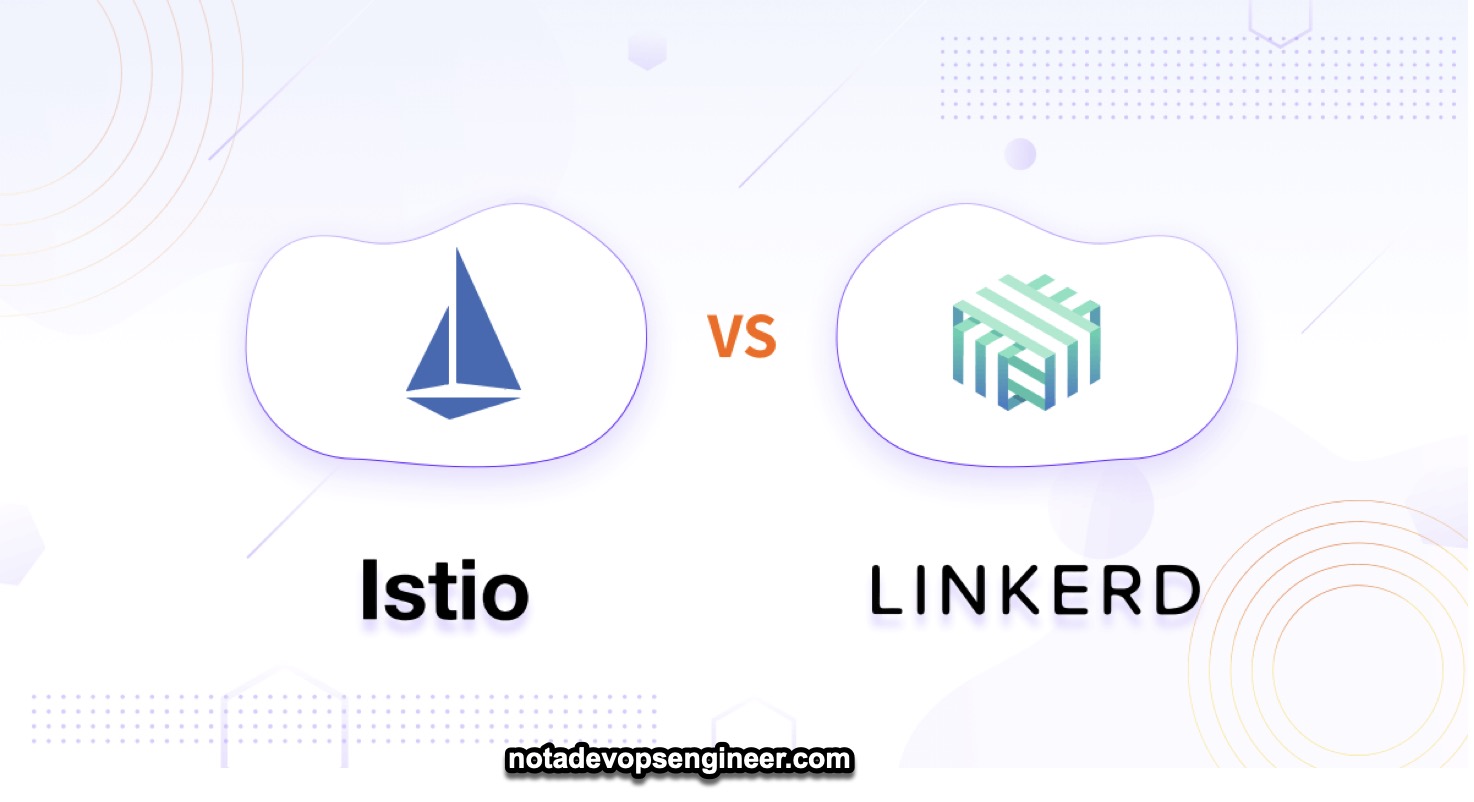11 min to read
Istio vs Linkerd
Service mesh battle

This document outlines different topics when comparing Istio and Linkerd, as well as these others:
- Core features comparison between both service meshes.
- Ingress comparison - contrasting Istio’s native ingress gateway with Linkerd + Nginx ingress controller
- Authentication capabilities - examining if Istio can replace Keycloak and comparing authentication approaches
The comparison highlights that Istio offers a more comprehensive but complex solution with built-in gateway capabilities, while Linkerd provides a lightweight, focused approach that works well with external components like Nginx and Keycloak.
Main Overview of the comparisson
| Feature | Istio | Linkerd |
|---|---|---|
| Architecture | Comprehensive, feature-rich | Lightweight, focused |
| Origin | Google, IBM, Lyft | Buoyant |
| Language | Go and C++ | Rust |
| Control Plane | Istiod | Multiple microservices |
| Data Plane | Envoy proxy | Custom micro-proxy (Linkerd2-proxy) |
| Resource Usage | Higher | Lower |
| Learning Curve | Steeper | Gentle |
| Extensibility | Highly extensible | Focused on core functionality |
| Community Size | Larger | Smaller but growing |
Core Functionality
| Feature | Istio | Linkerd |
|---|---|---|
| Service Discovery | ✅ | ✅ |
| Load Balancing | ✅ Advanced algorithms | ✅ Basic + EWMA |
| Fault Injection | ✅ Comprehensive | ✅ Basic |
| Circuit Breaking | ✅ | ✅ |
| Health Checks | ✅ | ✅ |
| Blue/Green & Canary Deployments | ✅ | ✅ |
| A/B Testing | ✅ | ✅ Basic |
| Traffic Shifting | ✅ | ✅ |
| Metrics & Monitoring | ✅ Comprehensive | ✅ Focused |
| Distributed Tracing | ✅ | ✅ |
| Mutual TLS | ✅ | ✅ |
| Policy Enforcement | ✅ Extensive | ⚠️ Limited |
| Multi-cluster Support | ✅ | ✅ |
| VM Support | ✅ | ❌ |
Ingress Comparison: Istio vs Linkerd with Nginx Ingress Controller
| Aspect | Istio Ingress Gateway | Linkerd + Nginx Ingress Controller |
|---|---|---|
| Architecture | Native component (Envoy-based) | Separate solution with integration |
| Installation | Part of Istio installation | Requires separate installation |
| TLS Termination | ✅ | ✅ (Handled by Nginx) |
| Routing Rules | Defined via Istio VirtualService & Gateway resources | Defined via Kubernetes Ingress resources |
| Advanced Traffic Management | ✅ Full Istio traffic management | ⚠️ Limited to Nginx capabilities + Linkerd routing |
| Protocol Support | HTTP, HTTPS, TCP, gRPC, WebSockets | HTTP, HTTPS, TCP, WebSockets (via Nginx) |
| Integration with Service Mesh | ✅ Native integration | ✅ Via annotations |
| mTLS at Ingress | ✅ Native support | ✅ Possible but more complex |
| Customization | ✅ Via EnvoyFilter | ✅ Via Nginx configuration |
| Performance | Good | Excellent (Nginx is highly optimized) |
| Resource Overhead | Higher | Lower |
Key Differences Between Istio and Linkerd
Digging more on the key differences between the two services meshes, we will discuss on specific key points that can add to the conversation and the selection of one.
1. Architecture
Both products use a similar architecture. They separate the control plane, which manages route data at the cluster level, from the data plane, which represents the functions and processes that transfer data from one interface to another on the service mesh.
Both use a “sidecar” mode, allowing agents to run in separate containers within each pod. The sidecar container sends and receives data to and from the application. It is responsible for transferring data to other pods or to destinations outside the cluster.
The key difference is the proxy used to perform this function:
- Istio uses the Envoy proxy, a de-facto industry standard with a community with 300+ companies making contributions. Envoy is a mature, battle-tested proxy that provides extensive features but comes with higher complexity and resource consumption. Istio’s control plane, Istiod, centralizes configuration management, certificate distribution, and service discovery.
- Linkerd 2.0 uses linkerd-2-proxy as its data plane proxy which has minimal industry support but is purpose-built for the service mesh use case. Written in Rust for memory safety and performance, the linkerd-2-proxy is significantly smaller and less resource-intensive than Envoy. Linkerd’s control plane is composed of several microservices (identity, controller, destination, etc.) that work together to provide mesh functionality.
Extensibility Comparison:
- Istio offers extensive customization through Envoy filters, WebAssembly plugins, and mixer adapters
- Linkerd focuses on simplicity, offering fewer but well-implemented extension points

2. Ingress
An ingress manages incoming traffic flowing into a Kubernetes cluster:
- Istio uses Envoy as the ingress through its Gateway resource. It provides solid functionality and was specifically designed for cloud native and Internet-scale API environments. Istio’s ingress gateway offers:
- Advanced routing based on headers, paths, methods, and more
- Traffic splitting for canary deployments
- Circuit breaking and outlier detection
- Rate limiting and quota management
- Custom filter chains for request/response manipulation
- First-class WebSocket, HTTP/2, and gRPC support
- Built-in certificate management
- Seamless integration with Istio’s service mesh policies
- Linkerd requires deploying a third-party controller such as NGINX to enable certain features such as rewriting incoming headers. Linkerd’s approach to ingress:
- Relies on standard Kubernetes Ingress resources
- Works with popular ingress controllers like NGINX, Traefik, or HAProxy
- Requires manual annotation of ingress resources to enable mesh features
- Provides “ingress” and “gateway” classes for integration with external controllers
- Limited native routing capabilities compared to Istio
- Requires additional configuration to achieve advanced traffic management
- Simpler to understand for teams familiar with standard Kubernetes primitives
Real-world Integration:
- Istio’s ingress is well-suited for environments requiring sophisticated edge logic
- Linkerd + NGINX offers a more modular approach that can leverage NGINX’s ecosystem

3. Egress
An egress controls outbound traffic from a cluster:
- Istio controls outbound traffic using virtual service objects and gateways. Its egress capabilities include:
- Dedicated egress gateways for securing outbound traffic
- TLS origination for external services
- SNI-based routing for TLS traffic
- Circuit breaking for external dependencies
- Ability to define ServiceEntry resources for external services
- Traffic policies for external endpoints
- Monitoring and metrics for external calls
- Ability to enforce mTLS between services and egress gateway
- Linkerd enables egress management but it is not straightforward and can only be achieved through DNS and delegation tables (DTAB). Linkerd’s egress features:
- Limited built-in egress control mechanisms
- Relies on service profiles for basic traffic management
- Supports “opaque ports” concept for non-HTTP traffic
- Can route through gateway nodes but with limited policy enforcement
- DTABs provide powerful but complex path rewriting
- No dedicated egress gateway component
- Requires additional tools for comprehensive egress control
Security Considerations:
- Istio provides more granular control over what external services pods can access
- Linkerd’s simpler approach may require additional components for complete egress security
4. Performance and Scalability
Depending on the application architecture, scalability requirements and configuration, Istio and Linkerd perform similarly, but Istio is deployed and proven in much larger environments:
- Istio uses Envoy proxy which is written in C++ and offers excellent performance. Istio’s performance characteristics:
- Higher memory footprint (~40-60MB per sidecar)
- CPU overhead typically 5-15% in production environments
- Demonstrated scalability to 5,000+ services in production
- Complex configurations can impact control plane performance
- Optimized for large enterprise environments
- Supports multiple clusters with federation capabilities
- Horizontal scaling capabilities for control plane
- Well-documented performance tuning options
- Linkerd uses a Rust-based micro proxy called Linkerd2-proxy, which drives the entire data plane and offers good performance in smaller environments. Linkerd’s performance profile:
- Minimal memory footprint (~10-15MB per sidecar)
- CPU overhead typically 3-5% in production environments
- Proven performance up to 1,000+ services
- Fast startup times and minimal latency impact
- Multi-cluster support but with less advanced federation
- Optimized for resource efficiency
- Limited horizontal scaling options for control plane
- “Ultralight” profile for extremely resource-constrained environments
Benchmark Comparison:
- Linkerd typically shows lower latency for simple HTTP requests
- Istio demonstrates better performance under complex routing scenarios
- Linkerd has significantly lower resource requirements at scale
5. Security
Both products have good native support for certificate rotation and external root certificates. Beyond this:
- Istio provides generally superior security features, including HTTP and TCP support for mutual TLS (mTLS). In terms of policy management, Istio allows various providers to integrate their products into its policy management framework, and supports setting rules to limit which applications can communicate with each other. Istio’s security features include:
- Authorization policies with fine-grained access control
- JWT validation and RBAC integration
- External authentication via request authentication policies
- Customizable PeerAuthentication policies
- Integration with external certificate authorities
- Secret discovery service for secure distribution of credentials
- Encryption of control plane configuration
- Support for SPIFFE identity framework
- Custom CA integration with Vault, cert-manager, etc.
- Linkerd supports mTLS by default for all TCP connections. Linkerd’s security approach:
- Automatic mTLS with minimal configuration
- Built around zero-trust networking principles
- Simpler policy model focused on core security needs
- Automatic certificate rotation with configurable validity periods
- Integration with external identity providers via API
- Limited but practical authorization policies
- Focused on securing service-to-service communication
- Less granular control but easier to implement and verify
Compliance Considerations:
- Istio provides extensive documentation for securing regulated environments
- Linkerd’s simpler model may be easier to validate but offers fewer controls
6. Monitoring
- Istio provides monitoring through a tight integration with Kiali. Kiali is an observability tool that can generate metrics, infer network topology, and integrate with Grafana for advanced query capabilities. Istio’s monitoring ecosystem:
- Comprehensive metrics collection across the service mesh
- Integration with Prometheus for metrics storage
- Built-in support for distributed tracing with Jaeger/Zipkin
- Service dashboard with detailed traffic visualization
- Health checking and workload analysis
- Custom metrics adapters for various backends
- Configuration validation and analysis
- Advanced alerting capabilities
- Traffic simulation and what-if analysis
- Linkerd provides out-of-the-box Grafana dashboards that provide insights into service communications. Linkerd’s observability features:
- Golden metrics (success rate, request volume, latency) focus
- Tap feature for real-time traffic inspection
- Built-in web dashboard with essential monitoring
- Live traffic sampling without additional infrastructure
- Service topology visualization
- Simple deployment debugging tools
- Prometheus integration for metrics collection
- Jaeger/OpenCensus integration for tracing
- Lower overhead metric collection
Real-world Monitoring Considerations:
- Istio provides more extensive metrics but requires more resources to process them
- Linkerd’s monitoring is lightweight and sufficient for most use cases
- Istio offers more visualization options through Kiali
- Linkerd’s tap feature allows debugging without external tools
7. Community Support
- Istio has a strong community backed by major companies like Google, IBM and Lyft. The Istio ecosystem offers:
- 25,000+ GitHub stars with 900+ contributors
- Regular releases with extensive documentation
- CNCF Graduated project status (as of February 2024)
- Enterprise support options from multiple vendors
- Extensive training resources and certifications
- Large ecosystem of compatible tools and extensions
- Active user groups across major global markets
- Regular community meetings and roadmap transparency
- Widespread adoption across enterprise environments
- Linkerd has a more focused community support. It was created by Buoyant, which remains the main corporate sponsor for Linkerd. Linkerd’s community includes:
- 10,000+ GitHub stars with 200+ contributors
- First CNCF graduated service mesh project (2021)
- Strong focus on user experience and simplicity
- Regular user success stories from production deployments
- Well-maintained documentation with practical examples
- Growing ecosystem of compatible tools
- Active Slack community with responsive maintainers
- Transparent, community-driven roadmap process
- Monthly community meetings with feature demos
Adoption Considerations:
- Istio is more commonly found in large enterprise environments
- Linkerd has strong adoption in mid-sized organizations prioritizing simplicity
- Istio has more commercial support options and consulting services
References:
- https://linkerd.io/2021/05/27/linkerd-vs-istio-benchmarks/
- https://istio.io/latest/docs/overview/why-choose-istio/
- https://www.buoyant.io/what-is-a-service-mesh
- https://www.solo.io/topics/linkerd/linkerd-vs-istio
Build On!

